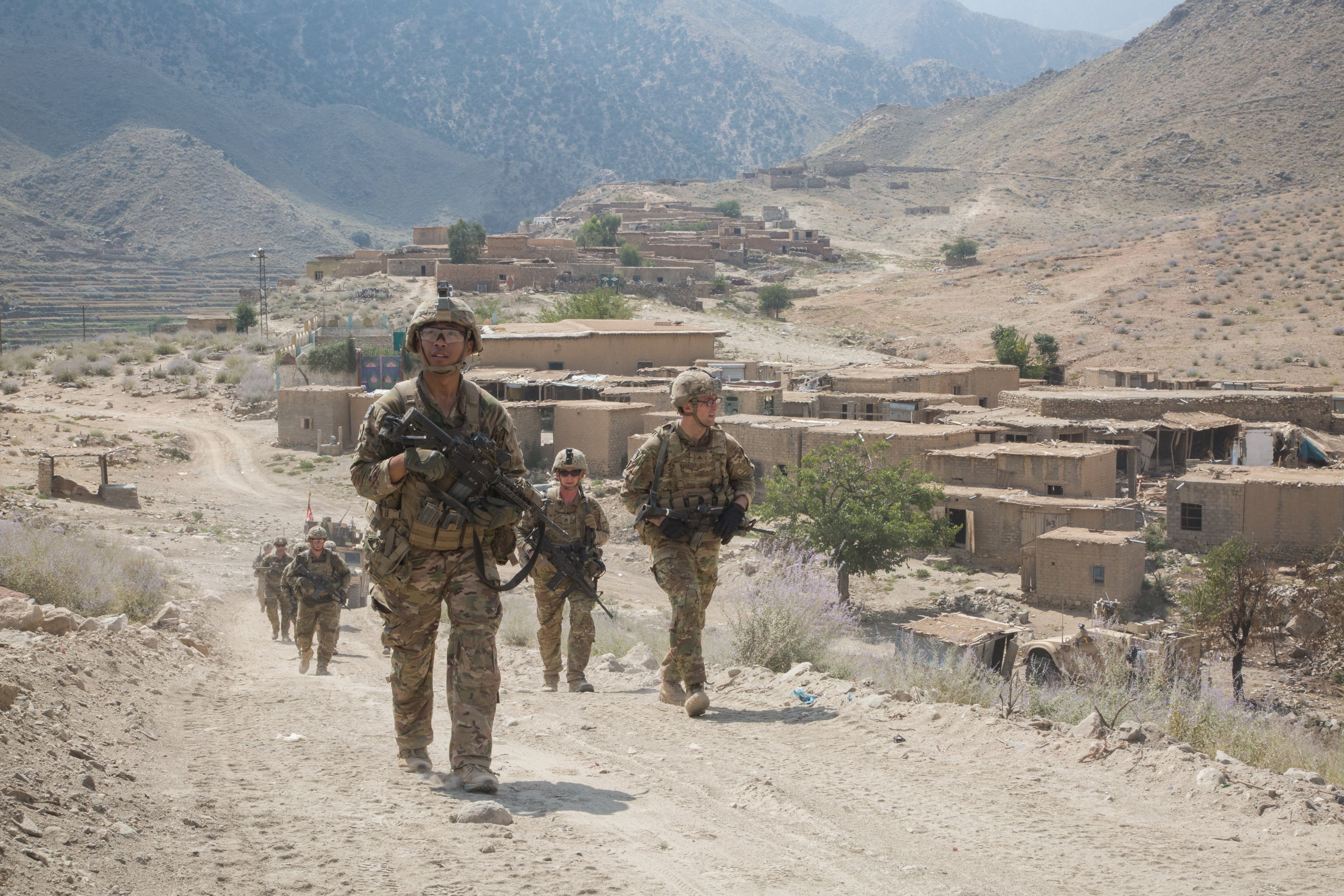Military and civilian leaders ignored a lot in both the planning and the ensuing 18 years of fighting in Afghanistan. A new report finds the most important thing they ignored was each other.
That’s one of a number of findings that the Center for Strategic and International Studies report “Tell me how this ends: Military Advice, Strategic Goals and the ‘Forever War’ in Afghanistan,” and the subsequent panel held Wednesday.
The eventual picture of U.S. involvement in Afghanistan should look something like what’s happening now in Somalia or Libya, a retired Army lieutenant general who sat on a panel discussing the report said.
Retired Lt. Gen. David Barno said when the United States withdraws it would monitor the situation in Afghanistan along the lines of whatever deal is agreed upon. Then, if “a certain threshold gets triggered, we would send forces in for a short raid operation” and use air power to deter any budding terrorist threat.
RELATED

Report author Mark Cancian is a retired Marine Corps colonel who now works as the senior adviser to the CSIS International Security Program.
Cancian’s 59-page report revisits the early days and objectives of invading Afghanistan and summarily tracks the wars unfolding and changing leadership over nearly two decades.
“The purpose of this project is not to indicate how to fight such wars better in the future," he wrote. “Rather, its goal is to aid in developing more insightful advice before wars begin, so that the United States can determine whether to get involved in the first place—and understand the likely duration and intensity of the commitment if it does.”
That came, in part, from a “significant chunk” of the military leaders’ thinking that civilians should “give us the mission, give us what we need to accomplish the mission and stay out of our way,” Cancian said.
The overriding belief that military leaders should not participate in discussions about goals and end states at all makes many military officers uncomfortable with the political dimensions of those discussions, Cancian wrote.
But by the end of his research, the retired colonel advises that military leaders need to “push back” against the civilian goals if the conditions are not favorable and they have to “give advice beyond simply how we’re going to do this.”
Cancian notes a “void” in military doctrine when discussing end states. Both the Field Manual 3-24 that covers insurgencies and countering insurgencies and the Joint Publication Doctrine of the Armed Forces of the United States, JP 3-0 Operations and its accompanying JP 5-0 planning, “do nothing to fill this void.”
The CSIS report lays out the case that after spending a combined $737 billion in military funds and another $44 billion in state department money, citing the book, “The $3 Trillion Dollar War,” by Joseph E. Stiglitz and Linda J. Bilmes and sacrificing 2,400 U.S. troops the situation at best in Afghanistan is a “stalemate.”
Some of what led to the stalemate includes:
- Ignoring that other nations might not have the same values that we do
- Ignoring the experience of the Soviets, who—despite obvious differences to the U.S. coalition—had tried to achieve many of the same social and political transformations, and who had experienced many of the same frustrations that the U.S. and NATO later experienced
- Ignoring the history of foreign occupations in general, which inevitably engender resentment against the foreign occupier
- Ignoring the history of Afghanistan, which had a precedent of being easy to conquer but difficult to occupy
- Ignoring why the Taliban fight, particularly their religious motivation
Meanwhile U.S. troop levels grew from 1,500 in country to nearly 100,000 at the peak of the war from 2010 to 2011. Since 2015 the numbers have hovered around 10,000 to 15,000.
But in other ways, the war is intensifying.
Munitions dropped rose from an estimated 2,000 in 2006 to more than 7,000 last year. That was not a steady increase. Numbers spiked during the peak of the war and dropped to early war levels through 2016, only to rise again during the President Donald Trump administration.
In a talk held to discuss and debate the report, Barno, a visiting professor of strategic studies at Johns Hopkins University and former senior commander of U.S. and coalition forces in Afghanistan from 2003 to 2005 found an early flaw – lack of continuity.
“By my count, we’ve had 11 different U.S. ambassadors and 17 different overall commanders in 18 years,” Barno said. “There’s no enterprise that I can envision that would have any kind of success if they had that kind of strategy.”
That’s resulted in very different pairings of civilian and military leaders across the span of time, oftentimes with very little common ground.
“It’s like 36, six-month wars,” Barno said. “It’s unprecedented in how the United States has ever pursued any conflict.”
Part of that is the often debated shift from counterterrorism tactics sought early in the war following the 9/11 attacks that sought to destroy Al-Qaida and prevent Afghanistan from becoming a safe haven for future terrorist attacks. But, the common thinking has gone that the mission shifted to counterinsurgency and nation building.
But it’s not that simple, panelists argued.
Jonathan Schroden directs research programs and special operations research at the Center for Naval Analysis and has deployed to Iraq and Afghanistan 10 times in his career.
He argued that both types of missions have been fought in parallel over the course of the conflict. Some of the military pursuing high-value targets in the counterterrorism role while other parts of the military and civilian corps pursuing a “comprehensive counterinsurgency” strategy.
Those came together early in the administration of President Barack Obama in a white paper that laid out strategic goals to disrupt, degrade and defeat Al-Qaida but pursued that aim with “maximalist, nation-building activities,” he said.
Panelists were critical of what the uniformed services could do even in the military role of nation building.
“The U.S. military does not have organic competency to build armies of foreign countries,” Schroden said.
He noted that some parts, such as the Army’s Green Beret teams and the newly formed Security Force Assistance Brigades, have that role. But the Green Berets are too small to do the work at scale and the SFABs are such a new concept they’re not quite proven yet.
But even the SFABs are not the ultimate solution, said Linda Robinson, senior international/defense research at RAND Corporation.
“The Army has not taken security force assistance seriously,” she said.
And, Schroden said, that’s not what the service was built for nor what leaders even want to do.
“The military greatly resists optimizing itself for unconventional wars,” Schroden said.
To do that, a lot has to change in the rank and structure of the services.
Cancian concludes his report with recommendations:
- Create a dialogue between senior military and civilian leaders about goals and end states
- Require more clarity from civilian officials
- Continue to develop military strategists
- Take seriously the history and experience of others
- Revise doctrine manuals to include a discussion of end states
Todd South has written about crime, courts, government and the military for multiple publications since 2004 and was named a 2014 Pulitzer finalist for a co-written project on witness intimidation. Todd is a Marine veteran of the Iraq War.
